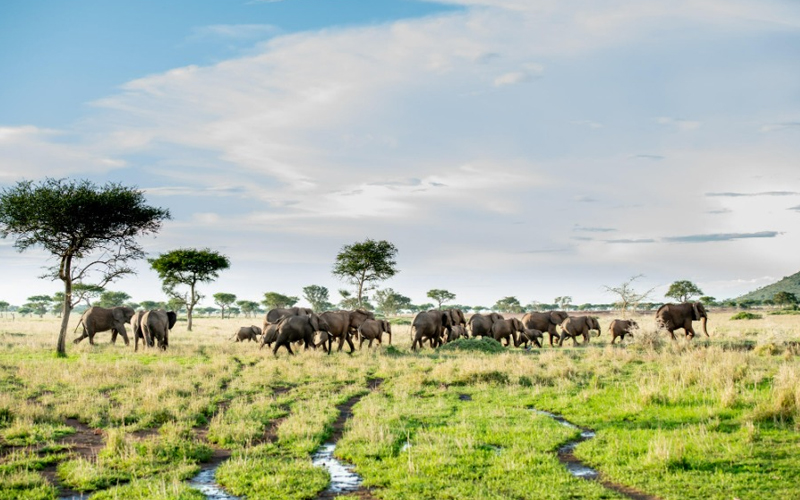Tanzania is renowned for its spectacular safaris, offering incredible wildlife sightings, breathtaking landscapes, and unforgettable experiences. However, choosing the best month for a safari can significantly impact your adventure. The timing of your visit can influence everything from weather conditions to animal behavior, so it’s essential to plan accordingly. This guide will help you determine the optimal time to embark on your Tanzanian safari.
Understanding Tanzania’s Climate
- Varied Climate Zones: Tanzania’s climate varies across different regions, from the coastal areas to the highlands. Generally, the country experiences two main seasons: the dry season and the wet season. Understanding these seasons is crucial for planning your safari.
- Dry Season: The dry season typically runs from late June to October. During this period, the weather is characterized by clear skies, sunny days, and cooler temperatures, especially in the evenings and early mornings. The dry season is considered the best time for wildlife viewing, as animals congregate around water sources, making them easier to spot.
- Wet Season: The wet season is divided into two periods: the short rains from November to December and the long rains from March to May. While the landscape is lush and green during this time, the rains can make some areas difficult to access, and wildlife can be more dispersed.
Best Month for a Safari: July to October
- Prime Wildlife Viewing: The period from July to October is often regarded as the best time for a safari in Tanzania. During these months, the dry season is in full swing, and the conditions are ideal for game viewing. Animals gather around rivers and waterholes, increasing your chances of seeing a diverse range of wildlife.
- The Great Migration: One of the most spectacular events during this time is the Great Migration, where millions of wildebeest, zebras, and other herbivores move across the Serengeti in search of fresh grazing. The best time to witness the river crossings, a highlight of the migration, is from July to August, particularly along the Mara River.
Benefits of the Dry Season
- Comfortable Weather: The dry season offers pleasant weather, with daytime temperatures ranging from 20°C to 30°C (68°F to 86°F). The cooler mornings and evenings make game drives more comfortable, and the lack of rain reduces the presence of mosquitoes and other insects.
- Clear Visibility: The sparse vegetation during the dry season provides excellent visibility for spotting wildlife. Animals are easier to see as they move through the open plains and congregate at water sources, making it an ideal time for photography.
Shoulder Season: January to February
- Calving Season: The shoulder season from January to February can also be a great time for a safari. This period coincides with the calving season in the Serengeti, where thousands of wildebeest give birth. The abundance of newborns attracts predators, offering dramatic wildlife encounters.
- Fewer Crowds: Traveling during the shoulder season means fewer tourists, allowing for a more intimate and peaceful safari experience. The landscapes are still lush from the short rains, and game viewing is still excellent.
Wet Season: March to May
- Lush Landscapes: While the wet season from March to May is not the most popular time for a safari, it has its own unique advantages. The landscape is vibrant and green, and the skies are dramatic, offering a different perspective of Tanzania’s beauty.
- Birdwatching: The wet season is a fantastic time for birdwatching, as migratory birds arrive, and resident species display their breeding plumage. The variety and abundance of birdlife can be astonishing.
Considerations for Wet Season Travel
- Accessibility: During the wet season, some roads and tracks can become impassable due to heavy rains. It’s important to plan your trip carefully and consider staying in lodges and camps with good infrastructure and accessibility.
- Wildlife Dispersal: With the abundance of water and food, wildlife tends to disperse, making animals more challenging to spot. However, the lush landscapes and fewer tourists can make for a unique and serene safari experience.
The best month for a safari in Tanzania largely depends on what you hope to experience. For optimal wildlife viewing, particularly the Great Migration, July to October is ideal. However, the shoulder season in January and February offers unique opportunities like the calving season and fewer crowds. Even the wet season has its charms, with lush landscapes and excellent birdwatching. By understanding the different seasons and their benefits, you can plan a safari that aligns perfectly with your interests and expectations.
FAQs
1. Is it possible to see the Great Migration year-round?
While the Great Migration is a year-round event, the best times to witness specific parts of the migration, such as the river crossings, are from July to August.
2. What is the weather like in Tanzania during the dry season?
The dry season typically has clear skies, sunny days, and cooler temperatures ranging from 20°C to 30°C (68°F to 86°F). It’s a comfortable time for game drives.
3. Are safaris more expensive during the peak season?
Yes, safaris can be more expensive during the peak season (July to October) due to high demand. Booking in advance can help secure better rates and availability.
4. What should I pack for a safari in Tanzania?
Pack lightweight, breathable clothing in neutral colors, a wide-brimmed hat, sunglasses, insect repellent, and a good camera. Layering is essential for varying temperatures.
5. Can I go on a safari during the wet season?
Yes, you can go on a safari during the wet season (March to May), but be prepared for lush landscapes, fewer tourists, and potentially challenging road conditions.
For an unforgettable Tanzanian adventure, explore the following highlights on our site:
- Ngorongoro Conservation Area
- Ngorongoro Crater Day Trip
- Serengeti Migration
- Tarangire Day Trip
- Tarangire National Park
- Zanzibar Vacation
Visit our page for detailed information and tips to plan your perfect Tanzanian journey.


